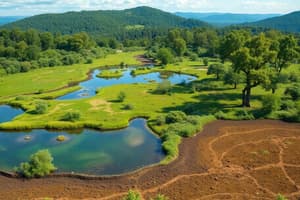Podcast
Questions and Answers
The Ecological Footprint is a resource accounting tool that helps countries manage their ecological resources and secure their future.
The Ecological Footprint is a resource accounting tool that helps countries manage their ecological resources and secure their future.
True (A)
What percentage of the world's population lives in countries running ecological deficits?
What percentage of the world's population lives in countries running ecological deficits?
80%
The organization responsible for the National Footprint and Biocapacity Accounts is called ______.
The organization responsible for the National Footprint and Biocapacity Accounts is called ______.
Footprint Data Foundation (FoDaFo)
What type of organization is Footprint Data Foundation (FoDaFo)?
What type of organization is Footprint Data Foundation (FoDaFo)?
Match the following with their connections to the Ecological Footprint.
Match the following with their connections to the Ecological Footprint.
What are the two key aspects measured by Ecological Footprint accounting?
What are the two key aspects measured by Ecological Footprint accounting?
The Ecological Footprint measures the amount of biologically productive land and water areas required to support a population's consumption and waste.
The Ecological Footprint measures the amount of biologically productive land and water areas required to support a population's consumption and waste.
What are the six main categories of productive areas measured by the Ecological Footprint?
What are the six main categories of productive areas measured by the Ecological Footprint?
A region's biocapacity represents the ______ of its ecological assets.
A region's biocapacity represents the ______ of its ecological assets.
What does it mean when a region has an ecological deficit?
What does it mean when a region has an ecological deficit?
Match the following terms with their descriptions:
Match the following terms with their descriptions:
What is the unit of measurement for both Ecological Footprint and biocapacity?
What is the unit of measurement for both Ecological Footprint and biocapacity?
The Ecological Footprint was developed by Mathis Wackernagel and William Rees in the year 2000.
The Ecological Footprint was developed by Mathis Wackernagel and William Rees in the year 2000.
Flashcards
Ecological Footprint
Ecological Footprint
A measure of how much demand human activities place on Earth's ecosystems.
Biocapacity
Biocapacity
The capacity of an ecosystem to regenerate resources and absorb waste.
Footprint Data Foundation (FoDaFo)
Footprint Data Foundation (FoDaFo)
An organization that governs the National Footprint and Biocapacity Accounts.
Ecological Deficit
Ecological Deficit
Signup and view all the flashcards
Global Footprint Network
Global Footprint Network
Signup and view all the flashcards
Ecological Risk Profile
Ecological Risk Profile
Signup and view all the flashcards
Sustainability Progress
Sustainability Progress
Signup and view all the flashcards
National Footprint Accounts
National Footprint Accounts
Signup and view all the flashcards
Ecological Footprint Explorer
Ecological Footprint Explorer
Signup and view all the flashcards
Footprint Scenario Tool
Footprint Scenario Tool
Signup and view all the flashcards
Global Hectares
Global Hectares
Signup and view all the flashcards
Biocapacity Reserve
Biocapacity Reserve
Signup and view all the flashcards
Footprint Movement
Footprint Movement
Signup and view all the flashcards
Carbon Demand
Carbon Demand
Signup and view all the flashcards
National Footprint and Biocapacity Accounts
National Footprint and Biocapacity Accounts
Signup and view all the flashcards
Study Notes
Ecological Footprint Accounting
- Measures demand and supply of nature
- Demand side: Calculates the biologically productive area needed for a population/product to produce resources (food, fiber, livestock, timber) and absorb waste (especially carbon emissions). Tracks cropland, grazing land, fishing grounds, built-up land, forest area, and carbon demand.
- Supply side: A region's biocapacity represents its ecological assets' productivity (cropland, grazing, forest, fishing, built-up). Healthy regions can absorb waste, including carbon emissions. Measured in global hectares (globally comparable hectares with world average productivity).
- Ecological Deficit: A region's demand on nature exceeds its biocapacity. Demand surpasses ecosystem regeneration for resources (food, meat, fish, wood) and waste absorption. This deficit is met by imports, resource liquidation (overfishing, deforestation), or carbon dioxide emissions.
- Biocapacity Reserve: A region's biocapacity exceeds its Ecological Footprint.
- Footprint Movement: Launched in 1990 by Mathis Wackernagel and William Rees, encompassing the carbon Footprint and widely used for ecological resource monitoring.
- National Footprint and Biocapacity Accounts: Produced for countries since 2019 by the Footprint Data Foundation (FoDaFo). York University maintains the accounts. Independent, unbiased data to inform decision-making.
- Ecological Footprint Explorer: Open data platform showing national comparisons.
Global Applications and Implications
- Over 80% of the world's population lives in ecologically deficit countries.
- National Footprint and Biocapacity Accounts are crucial for understanding ecological pressures and supporting sustainable development.
- Individual and collective action needed to address ecological limits.
- Investing in technology and infrastructure is vital for navigating climate change and resource constraints.
- Understanding risk profiles: Most countries are in ecological deficit, some rely heavily on external resources under pressure.
Studying That Suits You
Use AI to generate personalized quizzes and flashcards to suit your learning preferences.




